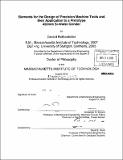Elements for the design of precision machine tools and their application to a prototype 450mm Si-wafer grinder
Author(s)
Rothenhöfer, Gerald S. (Gerald Sven)
DownloadFull printable version (20.29Mb)
Other Contributors
Massachusetts Institute of Technology. Dept. of Mechanical Engineering.
Advisor
Alexander H. Slocum.
Terms of use
Metadata
Show full item recordAbstract
Next generation precision machines will require ever more rigid elements to achieve the required machining tolerances. The presented work focuses on the application of ultra stiff servo-controllable kinematic couplings and hydrostatic bearings to minimize the structural loop of multi-axis precision grinding machines while reducing complexity. The fundamental importance of these ultra stiff, adjustable machine elements is demonstrated in the design of a grinding machine for 450mm diameter silicon wafers. A new generation of silicon wafer grinding machines is needed to back-grind large (450mm diameter) wafers from the production thickness of up to 1 mm down to less than 50pm so as to reduce the cost of Si-wafer based components. The grinding process needs to be done in about 90 sec (fine-grinding, e.g. -200 micron) to 160 sec (coarse grinding, e.g. -600 micron). After completion of the fine grinding process the wafer must be flat to 0.1 pm/o45mm and parallel to 0.6pm/450mm diameter. The surface roughness must be less than Rymax 0.1 pm and Ra 0.01 pm. Even though the required machining forces are <10N, the machine must be extremely rigid in order to achieve the necessary surface quality with a reasonable grinding feedrate. Assuming a feed-rate of 5m/min and a total allowable error motion of 5nm, a stiffness of >1 N/nm is required, which is many times stiffer than a typical machine tool (0.1 to 0.3 N/nm). In cooperation with industry, this work had the aim of creating a new machine design philosophy, with an example application that focuses on nano-adjustable kinematic coupling and feedback controlled water hydrostatic bearing technology. This new design philosophy is needed to enable the design of a relatively small footprint, compact precision machines. In particular, a ball screw preloaded height adjustable kinematic coupling and a magnetically preloaded hydrostatic thrust bearing were designed and built. The adjustable kinematic coupling allows for up to 8mm of vertical height adjust and 7N/nm stiffness at 26 kN preload. By varying the preload on the coupling by +/- 10%, in-process nm to micron height and tilt adjustment at >95% of the nominal stiffness is possible. Under the assumption of a constant flow supply, the hydrostatic bearing achieves a theoretical stiffness of 1 N/ nm at a 20 micron bearing gap and 7000 N combined gravitational and magnetic preload. In practice, the stiffness is limited by the pressure flow characteristics of the supplying pumps. To increase the bearing stiffness to a required 4N/ nm, various control loops have been developed and tested.
Description
Thesis (Ph. D.)--Massachusetts Institute of Technology, Dept. of Mechanical Engineering, 2010. Cataloged from PDF version of thesis. Includes bibliographical references (p. 155-160).
Date issued
2010Department
Massachusetts Institute of Technology. Department of Mechanical EngineeringPublisher
Massachusetts Institute of Technology
Keywords
Mechanical Engineering.